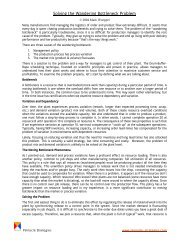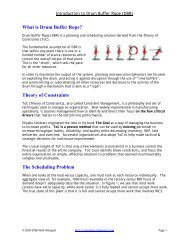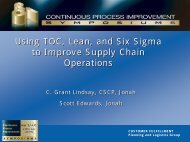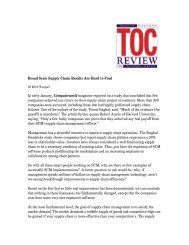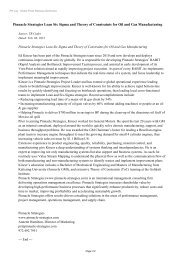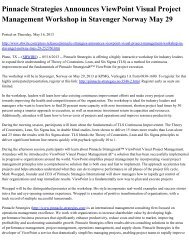CPM and CCPM a Compare and Contrast - Pinnacle Strategies
CPM and CCPM a Compare and Contrast - Pinnacle Strategies
CPM and CCPM a Compare and Contrast - Pinnacle Strategies
Create successful ePaper yourself
Turn your PDF publications into a flip-book with our unique Google optimized e-Paper software.
CRITICAL CHAIN AND CRITICAL PATH, CAN THEY COEXIST? SYNCHRONIZATION OF WORK Synchronizing plans to constraint resources properly staggers the introduction of projects. This ensures that the constraint resources will be available to work on the projects when they are needed. This drives shorter actual project completions <strong>and</strong> makes projected due dates more credible. IDENTIFYING SCHEDULE RISK Explicitly stating schedule risk gives project managers critical information, allowing them to focus on the few areas that impact the project delivery date <strong>and</strong> react accordingly. This helps maintain project due dates. Good planning processes are robust enough to minimize re-‐planning efforts during execution. Re-‐planning depletes management <strong>and</strong> resource time that is better used to solve problems <strong>and</strong> recover schedule slips. Allowances for schedule <strong>and</strong> technical risk should not be distributed across all tasks; they should be aggregated to provide the most protection <strong>and</strong> used during execution to focus management attention. ELIMINATE MULTITASKING Planning should reduce multitasking, the biggest cause of delays during execution. It is the biggest controllable cause of project delays, wasting time, creating re-‐work, <strong>and</strong> increasing project costs. The primary way planning reduces multitasking is by properly controlling the release of projects into the execution system. Through proper control, which begins in planning, you significantly reduce the amount of work in the system. This has the effect of reducing the workload on most resources, which in turn, reduces multitasking. PROVIDE CLEAR TASK PRIORITIES During execution, the plan should provide managers <strong>and</strong> resources clear task priorities within <strong>and</strong> across projects. In order to make the best decisions, managers must know what the impact would be on the project if they work one task versus another. It should provide clear information on where to direct shared resources to ensure the most rapid completion of the project. MAXIMIZE SCARCE RESOURCES The planning process should focus on leveraging the company’s scarce resources, their constraints. Exploiting the constraints produces more throughput for the entire system. PROJECT EXECUTION METHODOLOGY Projects are never executed by the project plan; there are many “great” plans, but as we know, there are very few “great” results. The plan is not the result; it is only one input to successful project execution. Project results are the product of a process that includes planning, but the plan is not the goal. In short, only what gets accomplished matters. Project success is the result of at least four major elements, one Plans Process Competence Reinforcement Results www.pinnacle-‐strategies.com 6



